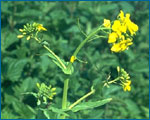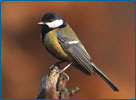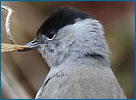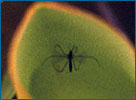Global warming is, quite literally, a hot topic. Though the mechanism of global warming — temperature rise due to humans’ production of heat-trapping greenhouse gases — may not be big news, the projected impact of global warming often makes headlines. Al Gore’s recent documentary on the topic has focused even more attention on the potentially disastrous effects of even a few degree temperature rise. Whole island countries could disappear into the ocean as polar ice melts and sea level rises. Hurricanes and tropical storms may intensify. And ecological interactions could change in unpredictable ways. For example, a recent news story reports that melting sea ice may be forcing some polar bears into cannibalism now that fewer seal hunting opportunities are available. Increasingly, it seems, global warming shows up on the front page of the newspaper — but the evolutionary implications of global warming often remain hidden.

Where's the evolution?
Global warming is certainly a climatic and environmental issue — but it is also an evolutionary one. Over the past 20 years, biologists have uncovered several cases of evolution right under our noses — evolution caused by global warming.
In this interview, Susumu Tomiya discusses how today’s high extinction rates may indicate that Earth is experiencing a sixth mass extinction. This video is produced by the National Evolutionary Synthesis Center (NESCent) and UCMP.
One of the key mechanisms of evolution, natural selection, causes organisms to evolve in response to a changing environment. Imagine a population with several different variants in it: some individuals happen to be better able to survive and reproduce at higher temperatures than other individuals. Clearly, if the temperature increases, those heat tolerant individuals will have an advantage and will leave more offspring — and those offspring will also carry the genes for heat tolerance. Over many generations, this process produces a population with adaptations well-suited for the hotter environment. So long as the population has different genetic variants in it, some better able to survive and reproduce in particular situations than others, the population has the capacity to evolve when faced with a changing environment.
Over the past 25 years, global surface temperatures have increased about ½°F. That might not sound like much, but it turns out to be more than enough to change the ecology and evolution of life on Earth. In many cases, these changes are simply non-evolutionary examples of phenotypic plasticity, where an organism expresses different traits depending on environmental conditions. For example, many organisms respond to warmer weather by reproducing earlier and taking advantage of an earlier spring — but this early reproduction is not caused by genetic changes in the population and so is not an example of evolutionary change. Similarly, many species have shifted their ranges in response to this tiny temperature difference, spreading towards the poles, as those habitats warm — but this change in range cannot be traced to a genetic shift in the population and so is not an example of evolution. And still other species simply seem to be on the path to endangerment or extinction as their habitats (like coral reefs) are degraded and their population sizes drop.
However, in a few cases, we know that species have actually evolved — experienced a change in gene frequency in the population — in response to global warming. Interestingly, in those cases, the species are not necessarily becoming more heat tolerant, but are adapting to changes in seasonal timing:
In a sense, these populations are the lucky ones. Small animals (like the birds, squirrels and mosquitoes described above) tend to have large population sizes and short generation times — and that bodes well for their ability to evolve along with a changing environment. Large population size means that the species is more likely to have the genetic variation necessary for evolution, and having a short generation time means that their rate of evolutionary change may be able to keep pace with environmental change. However, other species may not be so lucky: larger animals tend to have longer generation times and so evolve more slowly — and larger animals also tend to have smaller population sizes, which means that their populations are simply less likely to contain the gene versions that would allow the population to adapt to warmer climates. If global warming continues, such species may come face to face with extinction, as the environments to which they have been adapted over the course of thousands or millions of years change right out from underneath them in the course of a few decades.
News update, July 2008
Since we published this report in July 2006, we’ve been monitoring the news for other examples of evolution in response to global warming and have identified two to add to the list:
-

Brassica rapa. Photo © Br. Alfred Brousseau, Saint Mary’s College. Field mustard plants have evolved in response to an extreme, four-year-long drought in southern California, which some sources have linked to global warming. These plants flower and produce seeds near the end of the rainy season, but when the rainy season is cut short by a drought, late blooming plants may wither and die before they can produce seeds. This form of natural selection favors early bloomers. Is just four years enough time to see the results of this evolutionary shift? Researchers compared plants grown from wild seeds collected before and after the drought and found that post-drought plants had evolved to flower much earlier — sometimes by as much as 10 days!
-

Drosophila subobscura. Photo from George Gilchrist, Clarkson University. Scientists have been studying fruit fly genetics for a century. When they began to examine the genes found in whole populations of wild flies, they noticed a curious pattern. Certain chromosomal markers (inversions) were common in populations living in warmer climates near the equator, and others were common in more polar, cool-weather populations. It wasn’t clear what the genes associated with these different markers did exactly, but they seemed to help the flies cope with their divergent climates. Now, scientists have gone back to many of the fly populations first studied — and have found that as the global climate has warmed, the warm-weather genetic markers are becoming more and more common. Of the 22 fly populations on three continents that experienced warming trends, 21 seem to have already evolved in response to the climactic shift.
With rising temperatures and further climate fluctuations, we expect more examples of evolution in response to global warming to come to light. Such rapid evolutionary shifts are disturbing and suggest the gravity of this global threat, but even more unsettling is the likely fate of many species with long generation times and low levels of genetic variation: extinction. For these organisms, climate change may simply outpace their ability to evolve.
- For an easy-to-understand summary of global warming’s potential impact on many species, check out this article from Smithsonian.com.
Primary literature:
- Balanya, J., Oller, J. M., Huey, R. B., Gilchrist, G. W., and Serra, L. (2006). Global genetic change tracks global climate warming in Drosophila subobscura. Science 313:1773-1775. Read it »
- Bearhop, S., Fiedler, W., Furness, R.W., Votier, S.C., Waldron, S., Newton, J., Bowen, G.J., Berthold, P., and Farnsworth, K. (2005). Assortative mating as a mechanism for rapid evolution of a migratory divide. Science 310 (5747):502. Read it »
- Bradshaw, W. E., and Holzapfel, C. M. (2006). Evolutionary response to rapid climate change. Science 312:1477-1478.
- Franks, S. J., Sim, S., and Weis, A. E. (2007). Rapid evolution of flowering time by an annual plant in response to a climate fluctuation. Proceedings of the National Academy of Sciences 104:1278-1282. Read it »
- Nussey,D.H., Postma, E., Gienapp, P., and Visser, M.E. (2005). Selection on heritable phenotypic plasticity in a wild bird population. Science 310(5746):304-306. Read it »
- Réale, D., Berteaux, D. McAdam, A.G., and Boutin, S. (2003). Lifetime selection on heritable life-history traits in a natural population of red squirrels. Evolution 57:2416-2423. Read it »
News articles:
- A useful summary of the topic from National Geographic News
- A press release on evolution in Canadian squirrels due to global warming from the University of Alberta
- An article describing research on warming-related mosquito evolution from the BBC
Understanding Evolution resources:
- The basics of how natural selection works to produce adaptations
- A tutorial on microevolution, including a side trip addressing mosquito evolution in response to global warming
- A research profile that addresses another recent example of evolution in action — the evolution of antibiotic resistance
Background information from Understanding Global Change:
- How could global warming affect the evolutionary paths of different species?
- The process of natural selection involves variation, inheritance, selection, and time. According to this article, which of these elements is affected by global warming and how is it affected?
- Read “Hotspots for evolution,” which focuses on a different impact of global warming on evolution. According to that article, which aspect of natural selection (variation, inheritance, selection, or time) might be affected by global warming and how would it be affected?
- What is phenotypic plasticity? Give one example of phenotypic plasticity described in the article and one example that is not described in the article.
- According to this article, which species are less likely to evolve in response to global warming and why? How might global warming impact those species?
- The article above describes genetic variation as being critical for organisms to evolve in response to global warming. Read more about genetic variation, and explain what it is and why it is so essential to evolution.
- Teach about how environmental changes impact organisms: In this classroom activity for grades 3-5, students observe and conduct an experiment to see whether differences in salinity (the environment) have an affect on the hatching rate and survival of brine shrimp.
- Teach about natural selection: In this classroom activity for grades 9-12, students experience one mechanism of evolution through a simulation that models the principles of natural selection and helps answer the question: How might biological change have occurred and been reinforced over time?
- Teach about climate change and evolution: In this interview for grades 9-12, UC Berkeley Professor Anthony Barnosky gives the inside scoop on how climate change has affected past speciation of mammals and how it may affect biodiversity in the future.
- Balanya, J., Oller, J. M., Huey, R. B., Gilchrist, G. W., and Serra, L. (2006). Global genetic change tracks global climate warming in Drosophila subobscura. Science 313:1773-1775.
- Bradshaw, W. E., and Holzapfel, C. M. (2006). Evolutionary response to rapid climate change. Science 312:1477-1478.
- Franks, S. J., Sim, S., and Weis, A. E. (2007). Rapid evolution of flowering time by an annual plant in response to a climate fluctuation. Proceedings of the National Academy of Sciences 104:1278-1282.
- National Oceanic and Atmospheric Administration. (2006, Feb. 3). Global warming: Frequently asked questions. Retrieved June 27, 2006 from National Climatic Data Center.
- Phillips, J. (2007). Species explosion. Retrieved June 17, 2008 from Smithsonian.com.




